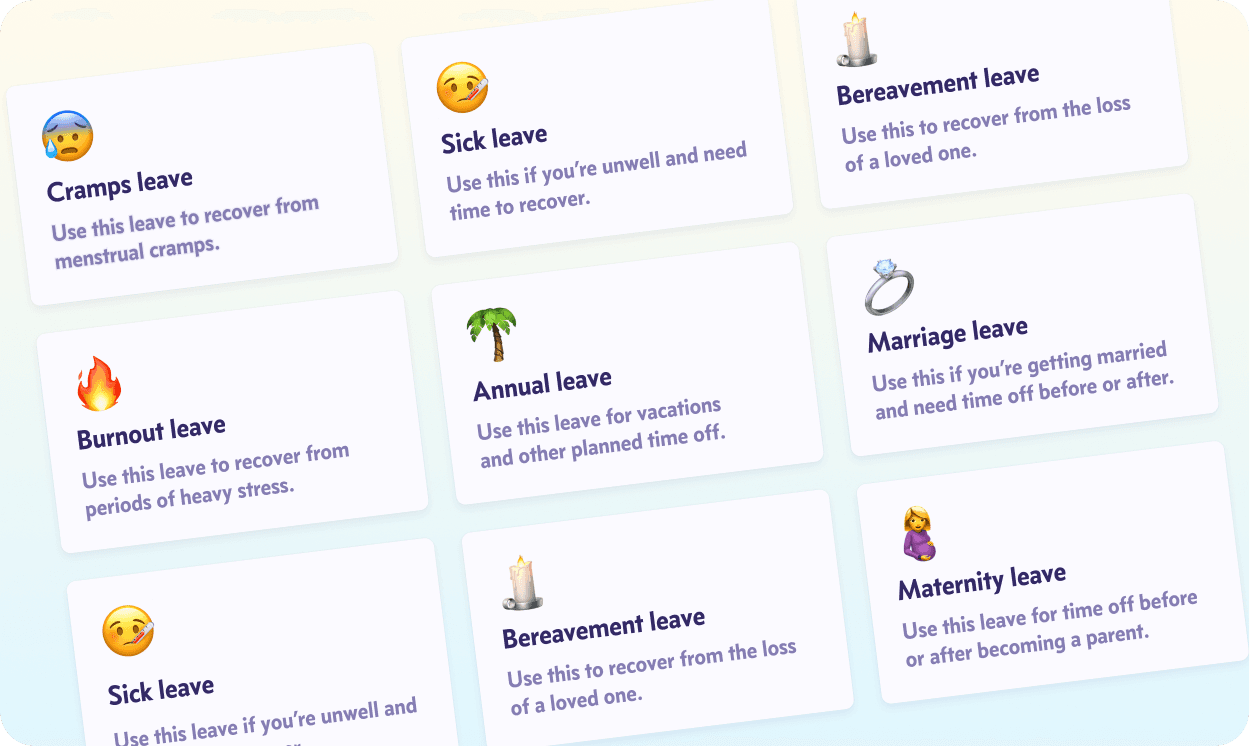5 strategies for managing employee absenteeism
Apr 27, 2023

Imagine this: You're working from home, just like everyone else on your team, thanks to the widespread adoption of remote work. It's Monday morning, and you log into your team's virtual workspace, ready to tackle the week ahead. As you check the online status of your teammates, you notice that several of them are offline or listed as "away."
You soon find out that a handful of employees are unexpectedly out sick or dealing with personal matters. This isn't the first time, and you can't help but worry about how this will impact your team's productivity and morale.
Sound familiar? You're not alone. Employee absenteeism is something that affects businesses of all shapes and sizes, whether they operate in traditional office settings or remotely.
In this article, we're going to talk about strategies to manage absenteeism effectively and keep your team happy and productive. So, let's dive in!
Understand the causes of absenteeism
To start, we need to understand why employees might be taking time off. Identifying the root causes will help you tailor your strategies to address absenteeism effectively. Here are some possible causes:
Physical health issues: Illness, injury, or work-related health issues like repetitive strain injuries or eye strain.
Mental health concerns: Stress, anxiety, depression, or burnout, which can be exacerbated by remote work.
Workplace factors: Negative work environment, lack of support, or interpersonal conflicts.
Personal issues: Family responsibilities, distractions, or inadequate workspace in a remote setting.
Lack of motivation or engagement: Disconnection from work or team, particularly challenging for remote employees.
Job dissatisfaction: Unhappiness with job, feeling undervalued, or lack of career advancement opportunities.
Inadequate training or resources: Feeling ill-equipped to perform job duties, especially with limited access to support in remote work.
Keep an eye out for patterns and trends that might reveal underlying causes, and develop targeted strategies to address these issues and support your team effectively.
Implement a comprehensive leave management system
One way to manage absenteeism is by implementing a comprehensive leave management system. Streamline the leave request process, track employee attendance accurately, and make sure you're complying with labor laws.
SaaS leave management tools can help you with this, making the whole process a breeze. With everyone working remotely, having a centralised system to track and manage absences becomes even more critical.
Develop a supportive work culture
Creating a work environment that supports your employees, whether in person or remotely, is crucial. Encourage a healthy work-life balance by setting boundaries for work hours and allowing time for breaks. Foster open communication, making it clear that employees can discuss any concerns or challenges they may face without fear of judgment or retribution.
Providing resources for your team's physical and mental well-being, such as access to online fitness classes or mental health apps, can also make a big difference. And don't forget to acknowledge and reward those who consistently show up and do their best, even in a virtual setting.
Implement flexible work arrangements
Remote work is already a flexible work arrangement in many ways, but you can take it a step further. Offering even more flexibility can contribute to reducing absenteeism. Consider giving employees the option to work different hours, like an early morning or late-night shift, as long as they fulfill their responsibilities. This can help accommodate employees with caregiving duties or those in different time zones.
Job sharing and part-time opportunities can also provide valuable options for those who need a lighter workload for a period of time.
Provide employee assistance programs (EAPs)
Employee assistance programs (EAPs) are another great strategy for managing absenteeism, particularly for remote workers who may feel isolated or overwhelmed.
Providing access to counselling, childcare, eldercare, and financial wellness programs can help address some of the underlying issues that lead to absenteeism. Virtual support groups or online workshops can also be helpful for remote employees, making it easy for them to access resources without having to leave home.
Foster employee engagement
Keeping your employees engaged, even when they're working from home, is essential. Include them in decision-making processes, and offer professional development opportunities through online courses, webinars, or mentorship programs.
Organise virtual team-building events, like online game nights or video conference coffee breaks, to help employees feel more connected to their coworkers. Addressing workplace conflicts promptly, even in a remote setting, can help maintain a positive atmosphere and reduce the desire for employees to "escape" through absenteeism. Make sure to have regular check-ins and one-on-one meetings with employees to discuss their progress and any concerns they may have.
Leverage technology for collaboration and communication
Remote work can sometimes lead to feelings of isolation and disconnection, which can contribute to absenteeism. To combat this, make sure your team has access to user-friendly and efficient collaboration tools that enable them to stay connected with their colleagues. Utilise video conferencing platforms for meetings, instant messaging for quick conversations, and project management tools to keep everyone organised and on track.
Encouraging the use of these tools can help your team feel more engaged and accountable, reducing the likelihood of absenteeism.
Create a remote work policy
A well-defined remote work policy can help set expectations for employees and provide guidelines on attendance, communication, and performance. This policy should outline how to request time off, how to track hours worked, and how to report absences, among other things. By providing clear expectations and guidance, you can help reduce the instances of unreported or unnecessary absenteeism.
Offer wellness initiatives
Promoting employee wellness, both physical and mental, is crucial in managing absenteeism. Encourage employees to take breaks, stretch, and get some fresh air throughout the day. You can also provide access to online exercise classes or wellness apps as part of your employee benefits package. Don't forget about mental wellness initiatives, such as mindfulness meditation sessions or workshops on stress management. Healthy, well-balanced employees are less likely to take time off work.
Monitor and evaluate absenteeism management strategies
Finally, don't forget to monitor and evaluate your absenteeism management strategies. Set measurable goals, review attendance data regularly, and adjust your strategies based on results and feedback.
Communicate your progress and achievements to your team to keep everyone informed and motivated. Regularly reevaluate your strategies to ensure they remain effective and up-to-date, adapting to the ever-evolving remote work landscape.
The final word
Managing employee absenteeism in a remote work setting can be challenging, but with the right strategies in place, you can keep your team happy, healthy, and productive. By understanding the causes of absenteeism, implementing a comprehensive leave management system, and fostering a supportive work culture, you'll be well on your way to reducing absenteeism and boosting morale.
Remember to be proactive, invest in employee well-being and engagement, and adapt your strategies as needed to keep your team at their best, no matter where they're working from!



